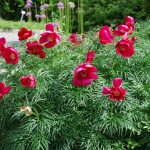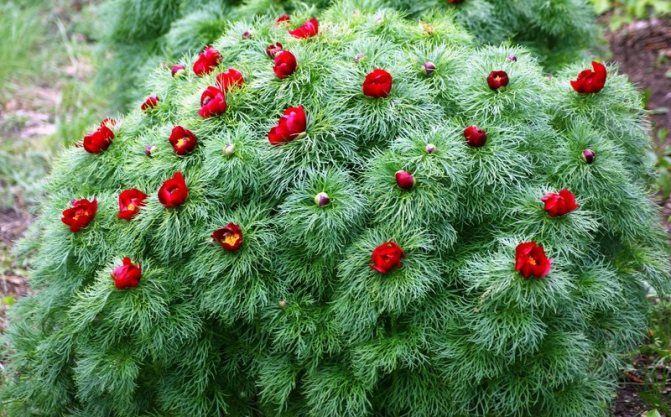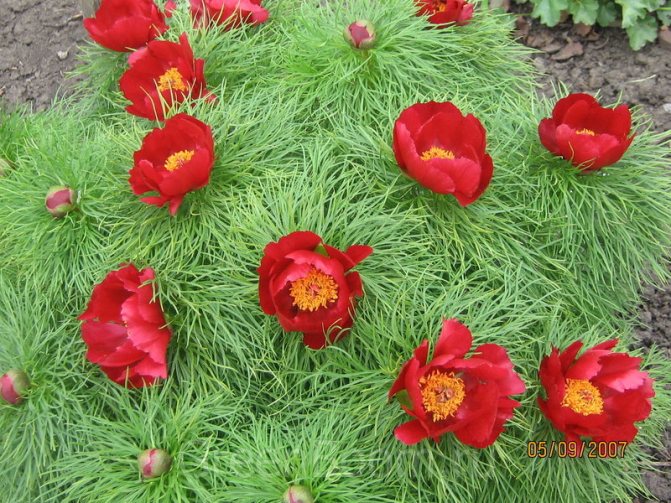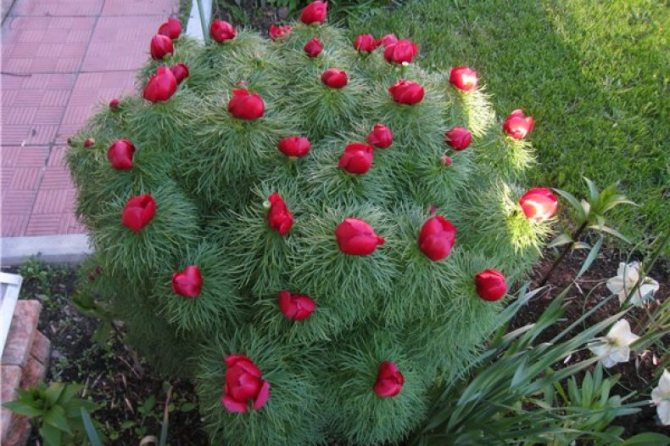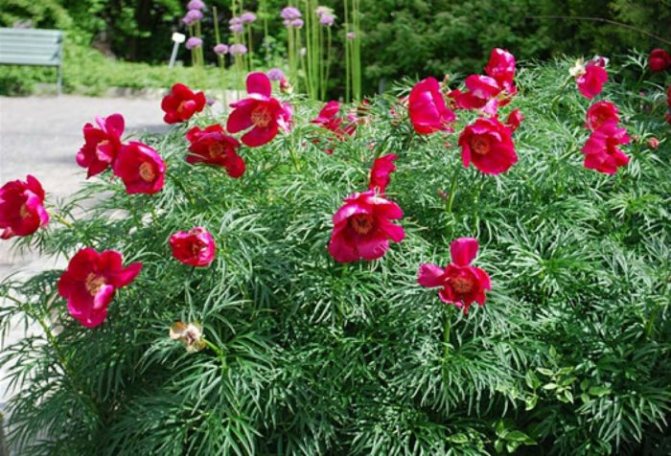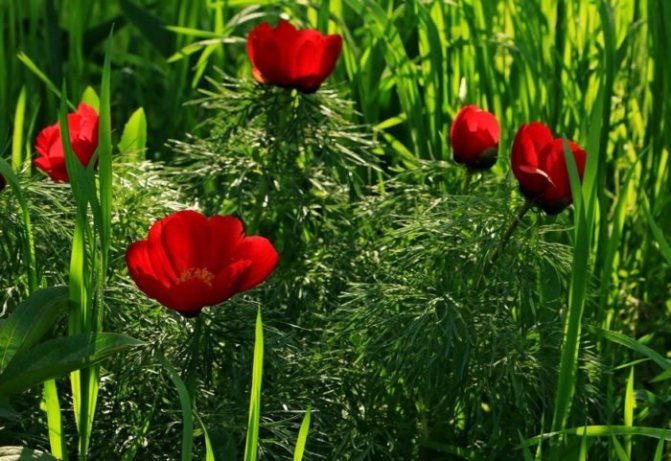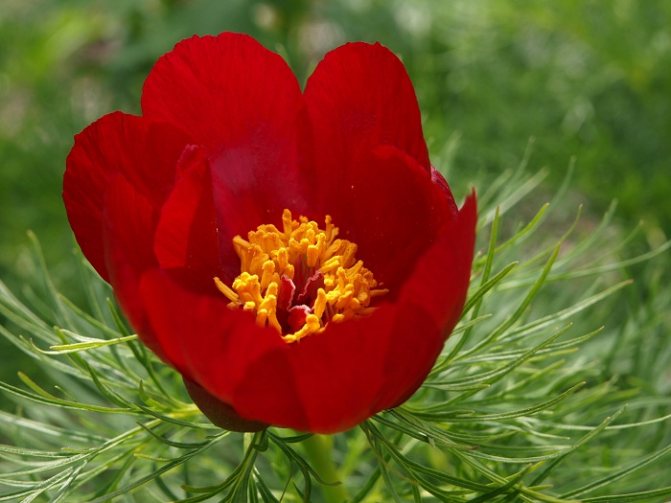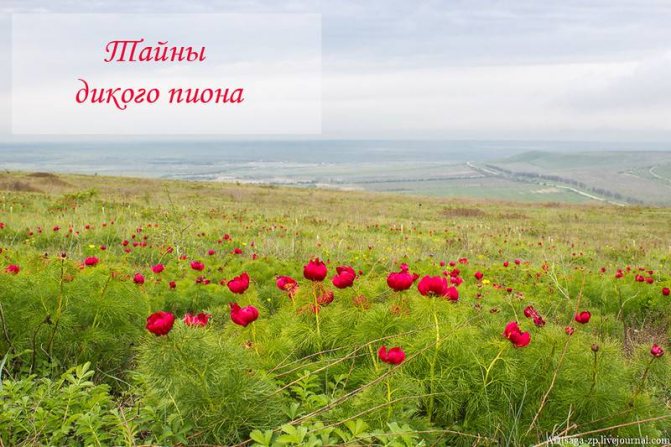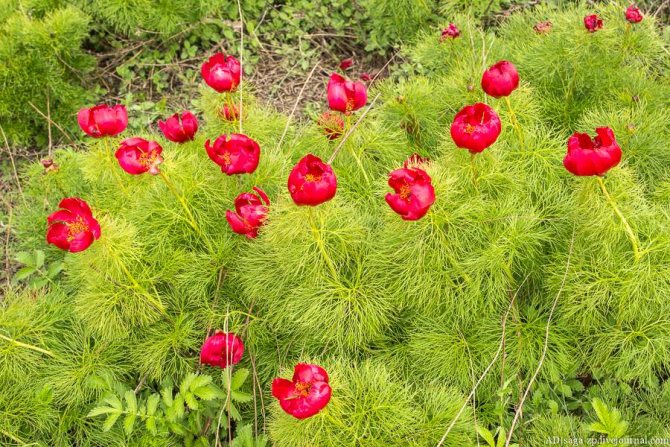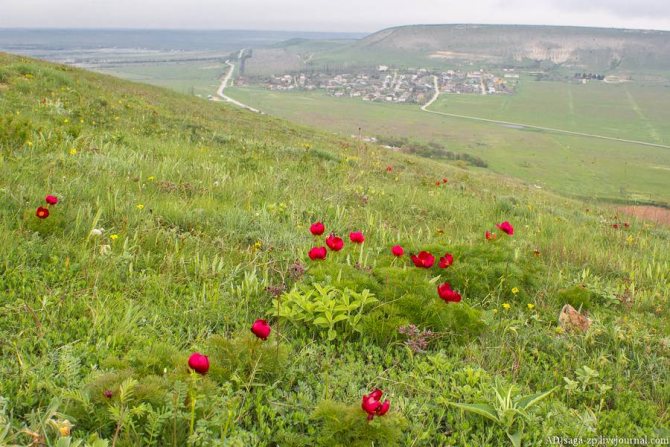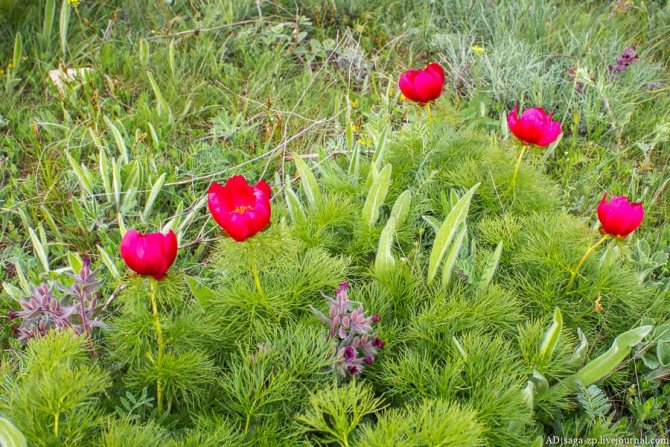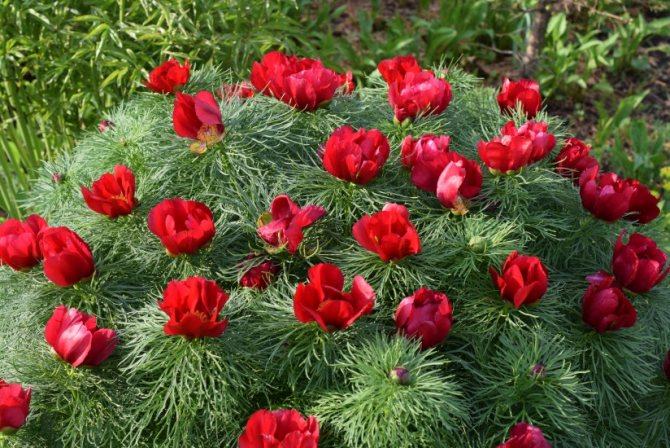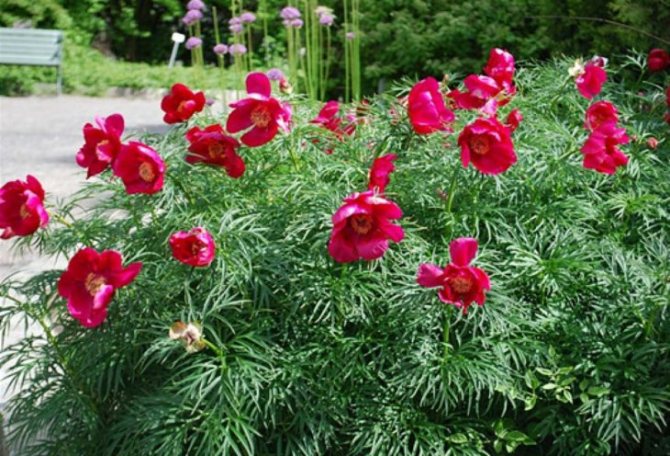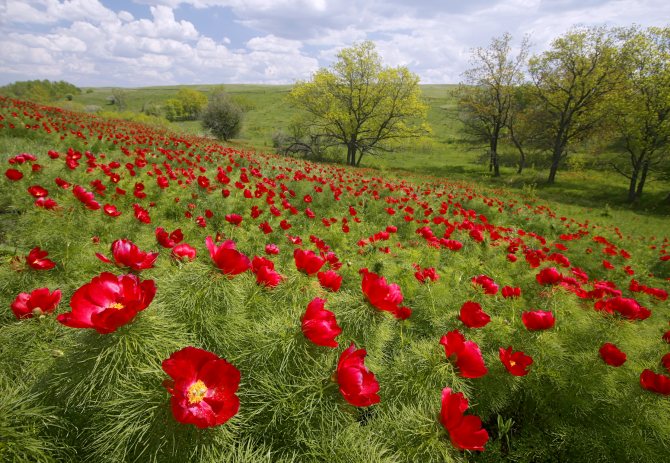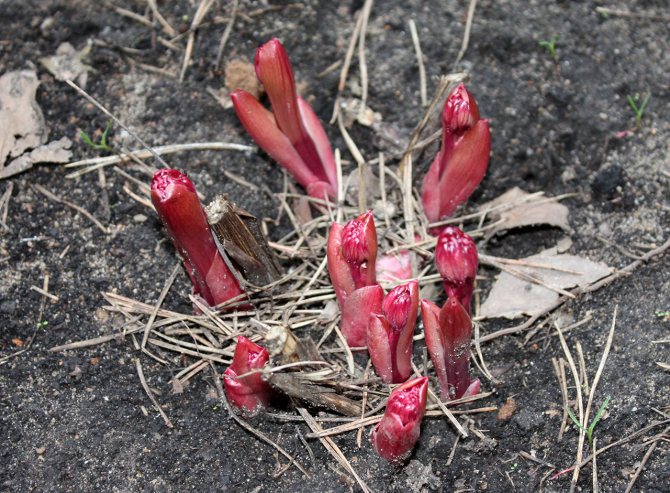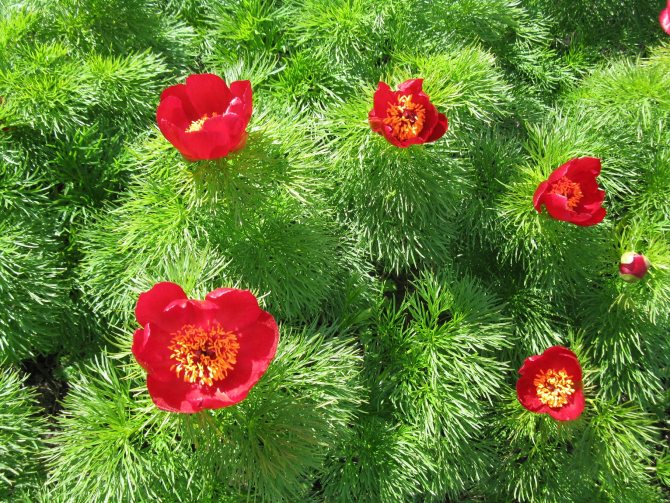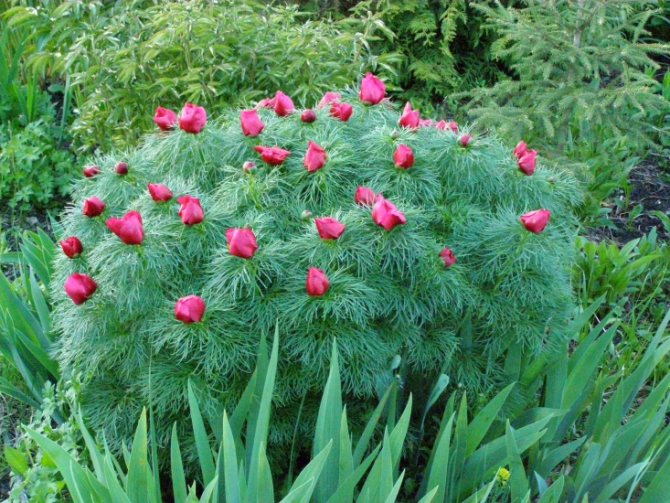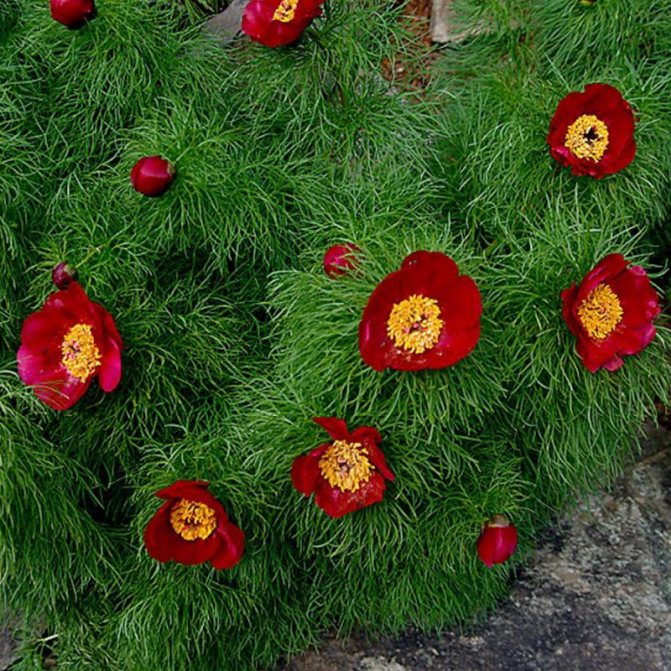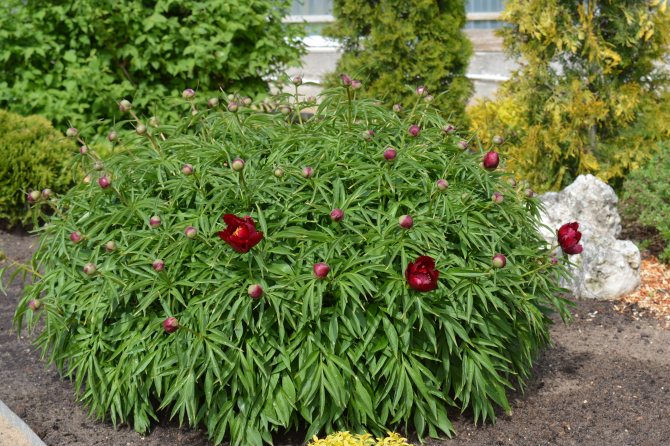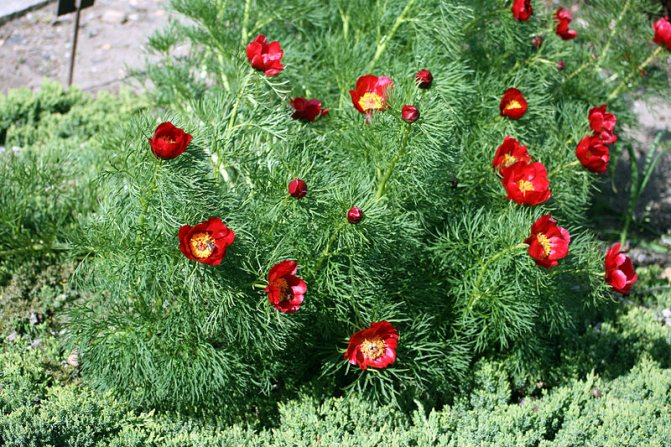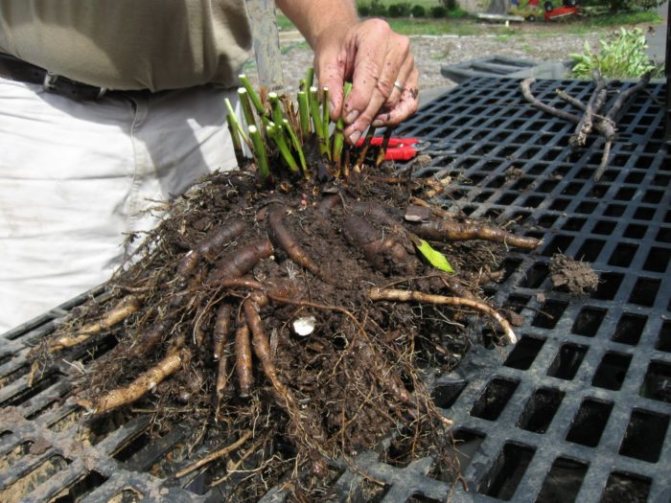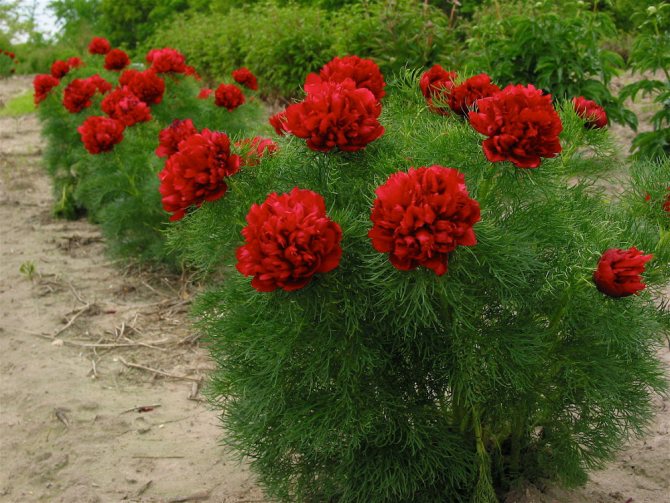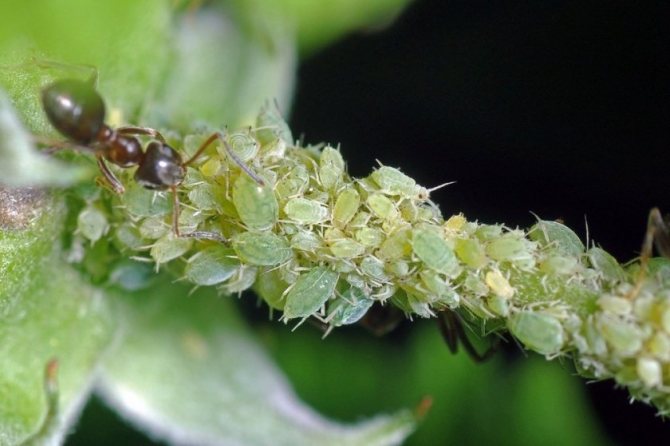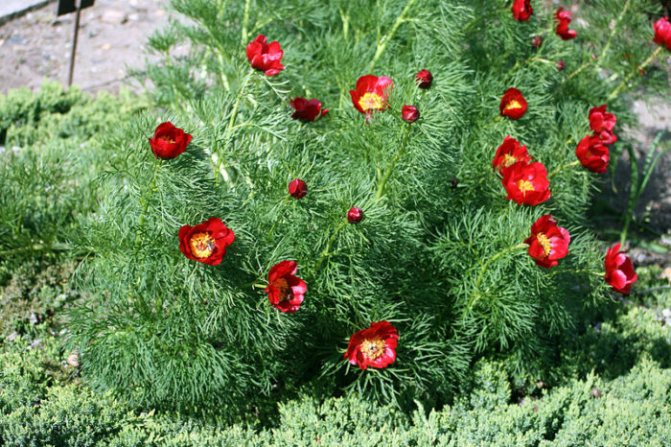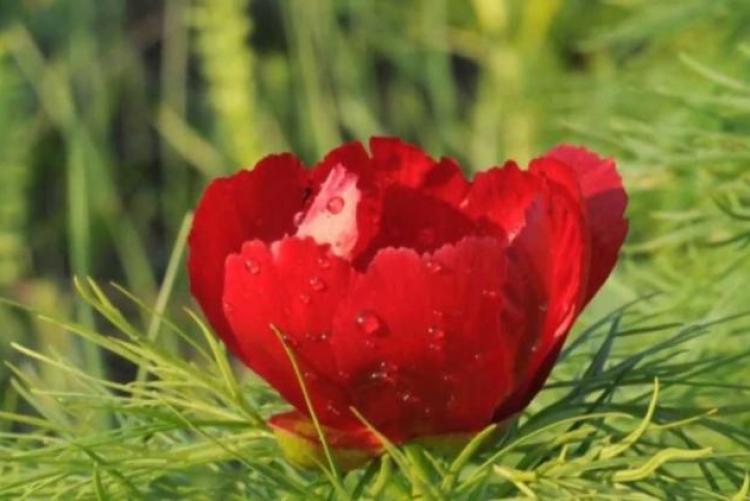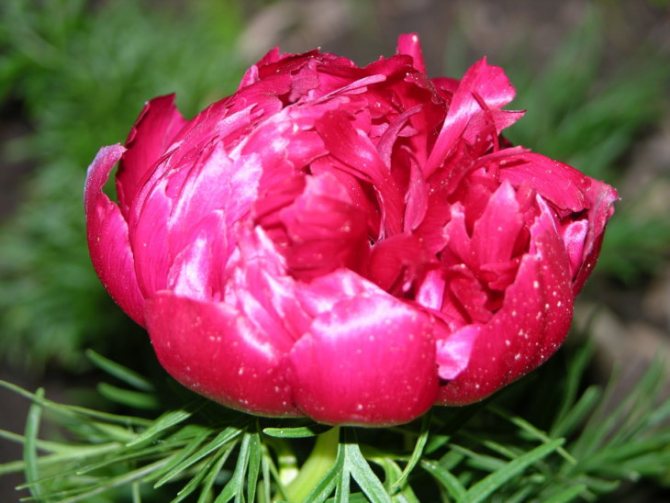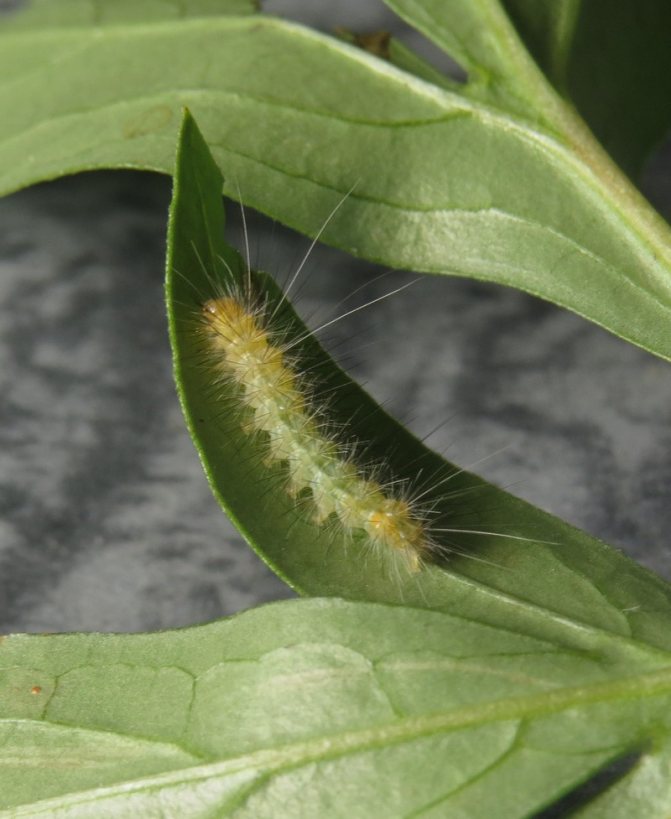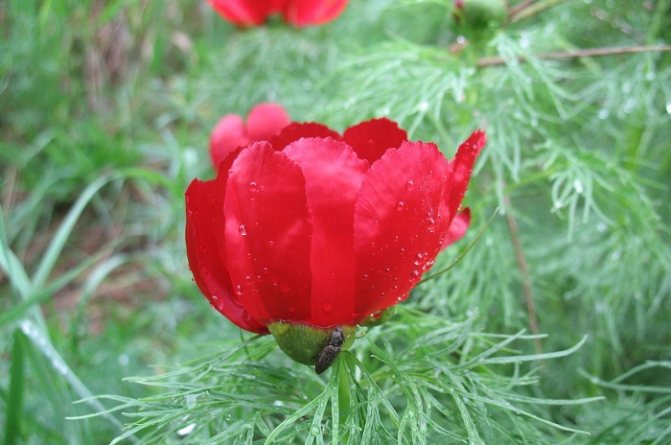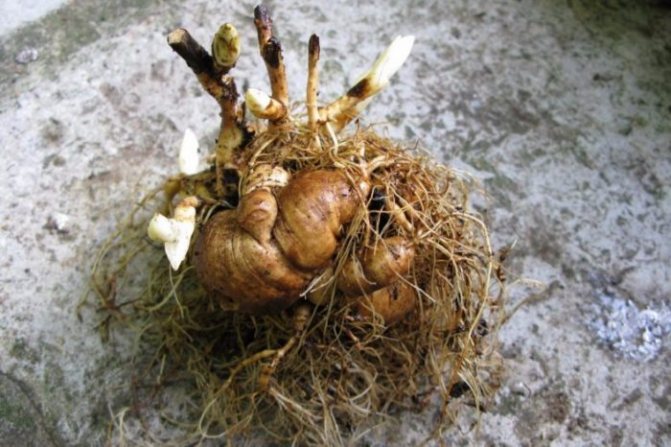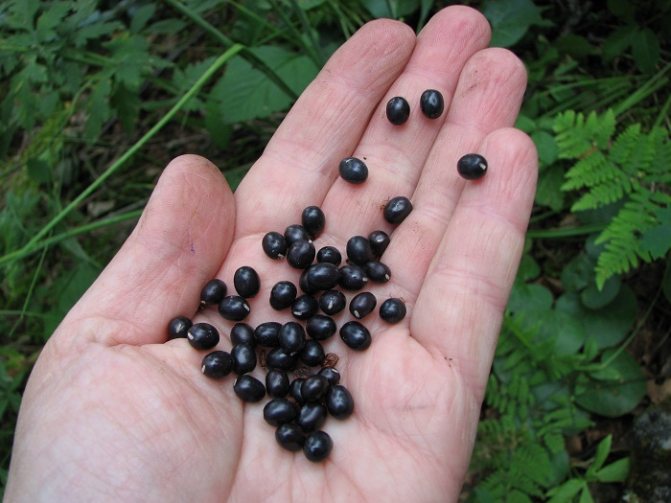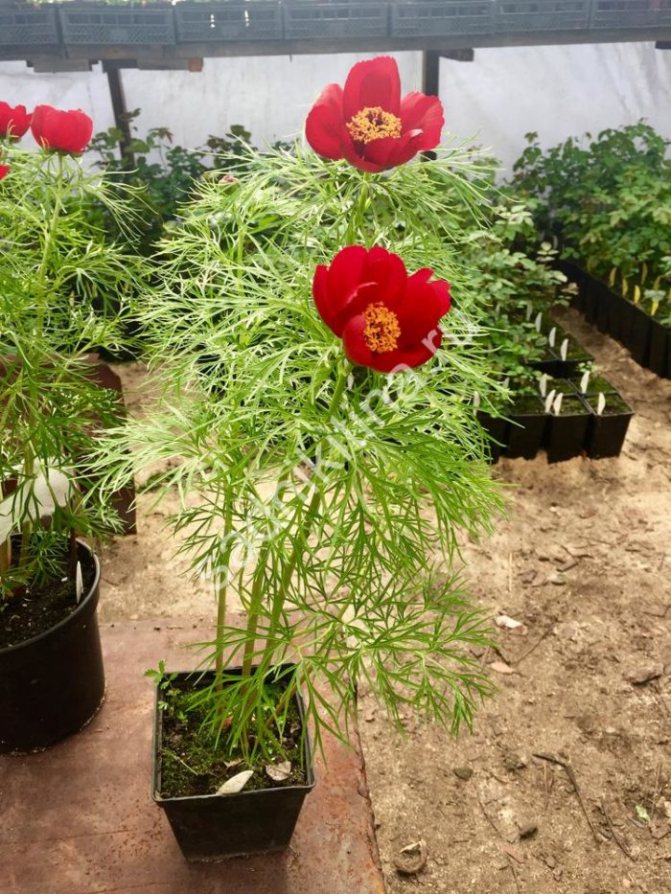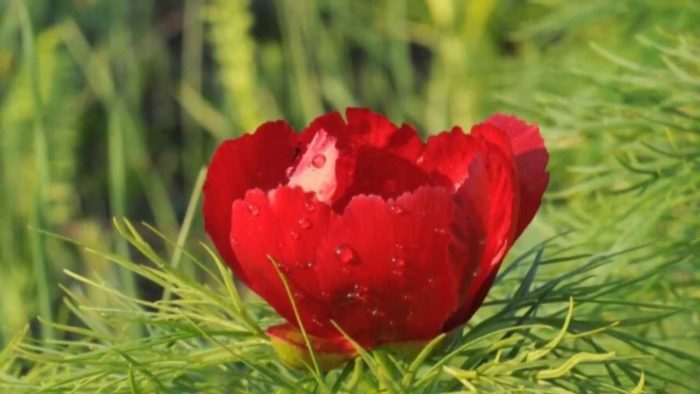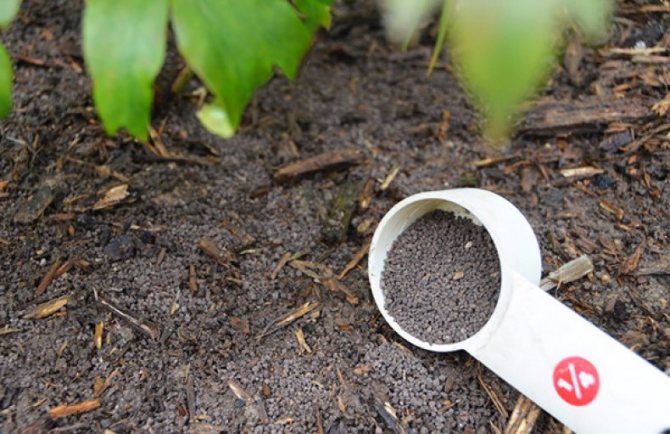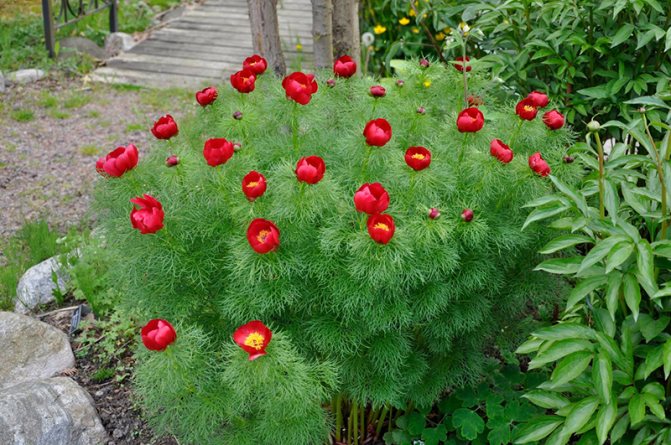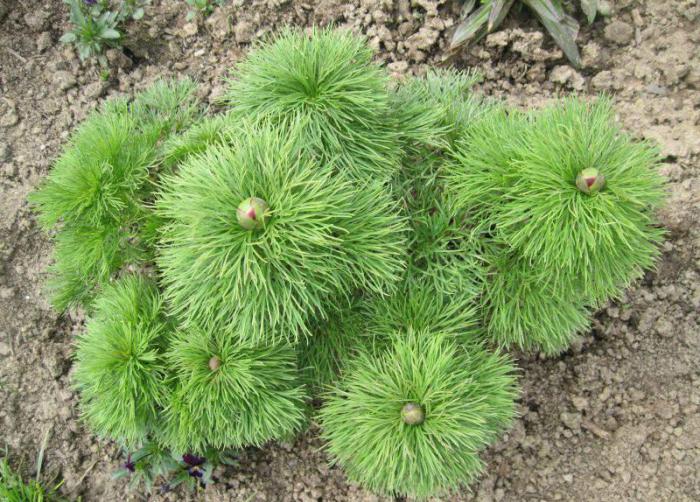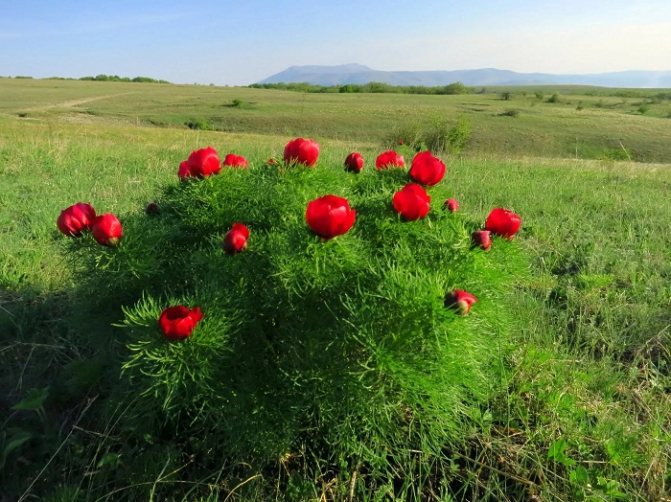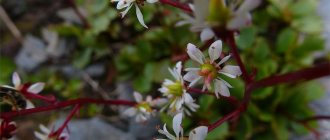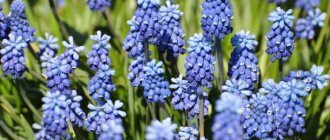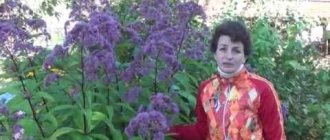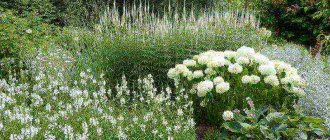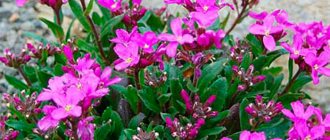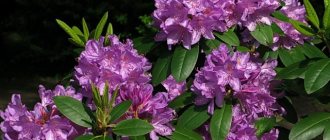The main / Garden and vegetable garden / How to grow a steppe peony and plant it beautifully on the site?
You can decorate a personal plot in different ways, one of them is planting wild-growing perennials. They are perfect for most styles and also require little maintenance. Therefore, they are in demand in landscape design. One of these plants is the steppe peony.
Description and features
The narrow-leaved peony that grows naturally is called the raven. Today there are more than 20 varieties of such crops. Breeders managed to breed a terry crop. The plant does not produce seeds, and therefore it can only be propagated by dividing the root system.
The thin-leaved peony reaches a height of 40-60 centimeters. A lot of buds are formed on it, the diameter of which is 8-10 centimeters. All flowers appear at the same time. Thanks to this, you can admire lush bouquets for 7-10 days.
A perennial plant does not lose its beauty even after flowering. Its thin leaves are fern-like and have excellent decorative properties..
Characteristic
The steppe peony is a perennial plant and belongs to the Peony family. In nature, it can be found in the vastness of Asia, Siberia and Altai, in the steppes, on stone slopes and hills.
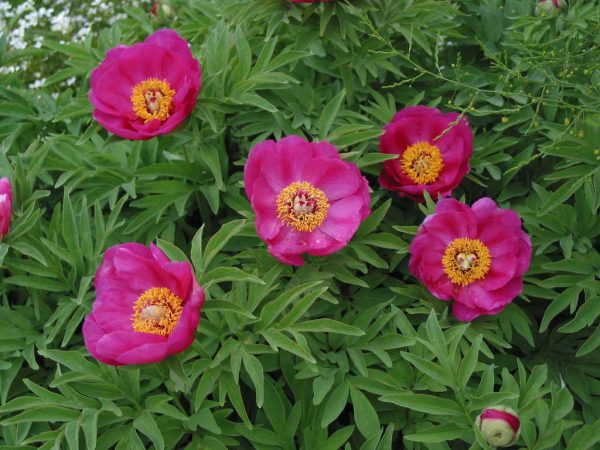
A steppe peony forms one stem, 15-30 cm high, on the top of which one bud flaunts, of a bright purple color. The diameter of the opened flower can reach 9 cm. The flowering period is short, only a few days. But since it grows well, it is practically not noticeable and the whole flowering process stretches over May-June. Leaves are dvadtrychatye and slightly omitted.
In addition to its beautiful appearance, the steppe peony belongs to medicinal plants. Therefore, it is often harvested in its natural habitat. This led to a decrease in the number of plants and their inclusion in the Red Book.
The steppe peony grows successfully in botanical gardens throughout the continent. The advantage of the plant is that it is winter hardy and has a beautiful appearance.
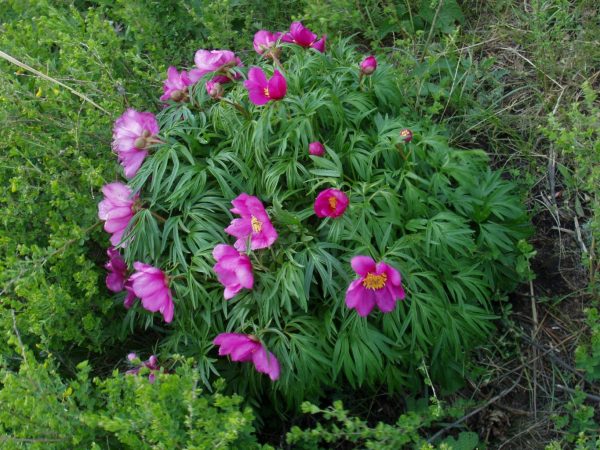

Beneficial features
This culture has poisonous properties. However, at the same time, it is actively used in medicine. This is due to the expectorant, analgesic, bactericidal characteristics. Peony is an effective antispasmodic and helps fight off parasites.
Plant-based substances are often used to combat anemia. They can be used for coughs and syphilis. From the roots of the peony, you can prepare funds to eliminate tuberculosis and pathologies of the heart and blood vessels.
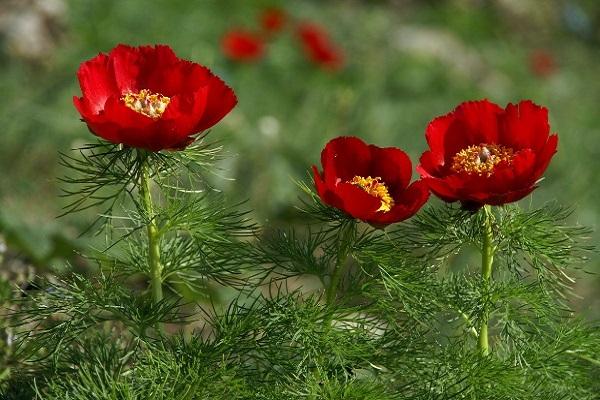

The plant contains tannins and anthocyanins. It also contains flavonoids, vitamin C, fatty oil. All of these substances are required for the manufacture of drugs. Also, the plant is valued for its melliferous characteristics.
Chemical composition
Despite its widespread use in medicine, the raven is a plant whose chemical composition has been poorly studied. Modern science knows that the "azure flower" is distinguished by the presence of tannins, flavonoids, in particular quercetin, kaempferol, ranunculin, flavescetin.
Fresh peony leaves are home to ascorbic acid, and the root cones contain cardiac glucosides.
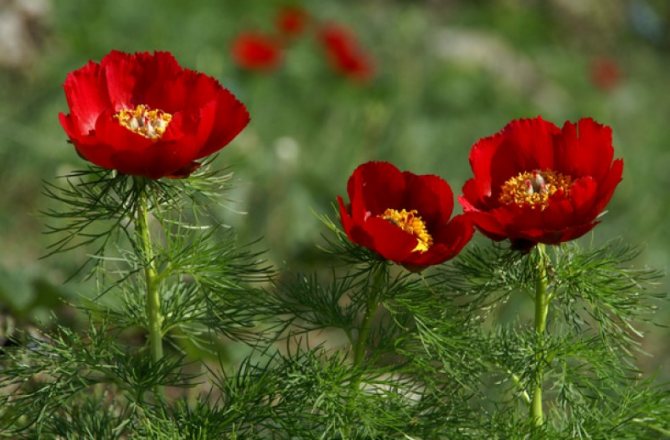

Popular varieties
There are quite a few varieties of this type of peony. Each of them has certain features.
Rubra plena
This plant has a compact bush that reaches 50 centimeters. Scarlet double flowers are 10 centimeters in diameter. Flowering begins in May. Although the culture does not bloom for long, its decorative properties can be preserved until August.
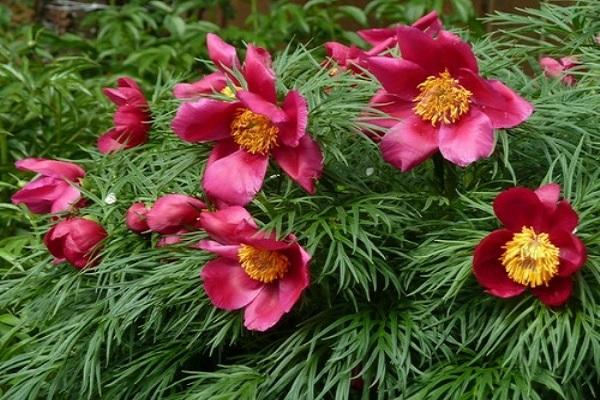

Tiny Tim
It is a hybrid characterized by carved red petals. Their diameter is 8 centimeters. The culture is characterized by early flowering and the absence of special requirements for the composition of the soil. The plant thrives on rocky soil. It is actively used for rock gardens.
Early scout
The peony of this variety reaches 50 centimeters in height. The diameter of its flowers is 12 centimeters. The culture is characterized by thin lanceolate leaves of a dark green hue. The bush is impressive in size and retains its decorative properties throughout the warm season. The flowers have a bright red hue and a laconic shape.
The culture is resistant to frost. Therefore, it is possible not to cover it for the winter. The peony begins to bloom in the second half of May.
Eaglet
This variety is characterized by a beautiful bush shape. It has slightly deflected stems and green glossy leaves. The plant reaches a height of 60 centimeters. It is characterized by simple flowers up to 10 centimeters in size. They have a red tint. Under the influence of the sun, the petals acquire a carmine hue.
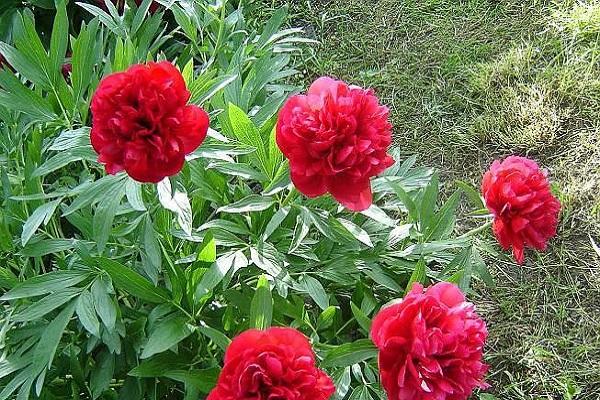

Pests and diseases
The steppe peony can become a victim of an invasion of aphids and various types of caterpillars, which taste juicy and soft foliage. This happens mainly during the growth of the stem and budding. As soon as the first traces of the presence of pests appear, it is necessary to start treating flowers with insecticides as soon as possible.
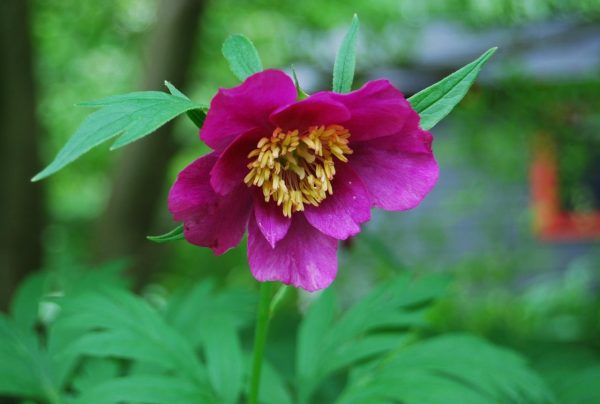

You can buy them in a specialized store. It is very important to dilute the drug according to the instructions. Plants are processed early in the morning or in the evening, on a dry and calm day, so that the drug does not scatter around the site and can be absorbed into the plant on its own. It is strictly forbidden to process during the day, since burns may appear on the plant under the influence of sunlight.
It is not difficult to grow a steppe peony. It has a lot of advantages, so you should definitely plant it on the site in order to decorate it and fill it with lightness and freshness.
AllaAuthor of the article
Did you like the article?
Landing
To get a strong and viable plant, it is worth choosing the right place for planting it and providing it with adequate care.
See also
Characteristics and description of Sorbet peonies, planting and careRead
Seat selection
The plant grows well in sunny areas. In the shade, the crop can also be grown, but in this case it may not bloom. It is forbidden to plant a narrow-leaved peony in a lowland, since it hardly perceives stagnant liquid. The natural habitats include the slopes of gullies and ravines, dense thickets, edges.
The culture goes well with other plants. It can be safely planted near junipers or conifers. Also, the plant grows well in combination with herbaceous peonies.
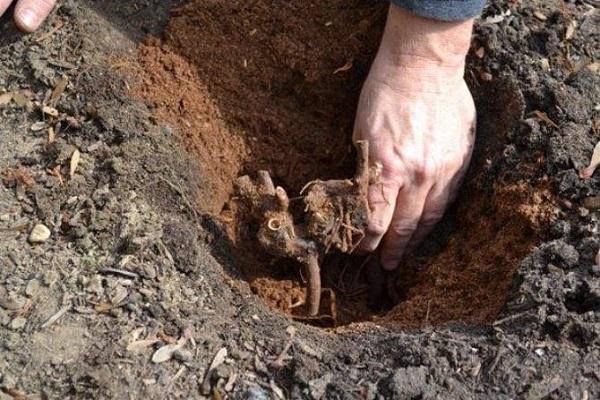

Soil requirements
High-quality drainage is considered a key requirement for the soil. It is important that the liquid goes away quickly. This will help prevent the development of fungal diseases. The soil should be neutral or slightly alkaline.
Soil preparation
It is recommended to make a hole under the seedling. Its diameter and depth should be 50 centimeters. Drainage is installed at the bottom. It is made from crushed brick, expanded clay or gravel.The height of this layer should be 20 centimeters.
It is worth pouring garden soil on top. It is recommended to mix it with compost, humus. You can also use mineral dressings and dolomite flour.
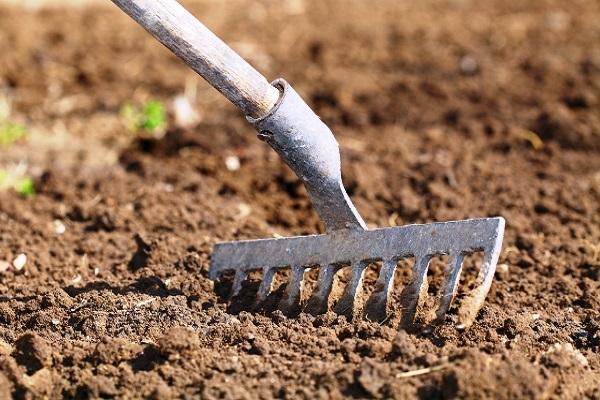

Timing
It is best to plant a peony in August or September. It is at this moment that the vegetative period of the ground part ends. Thanks to this, the roots of the plot take root easily and do not expend energy on the shoots.
When planting, it is not recommended to deeply deepen the plant. It is important that the kidneys are 3-5 centimeters below the surface of the earth. In spring, the plant can also be planted. It will be accepted, but it will lag behind in development.
Landing scheme
It is allowed to deepen the peony by a maximum of 10 centimeters. After separation, the bushes should not be immersed more than 3-5 centimeters. Otherwise, they will not be able to fully bloom.
It is important that the root system does not touch the fertilizer layer. After the end of planting, it is worth making an elevation around the plant. Its height should reach 10-12 centimeters. The land can be replaced with peat or humus. It is forbidden to tamp the soil in the planting area. This will damage the fragile root system.
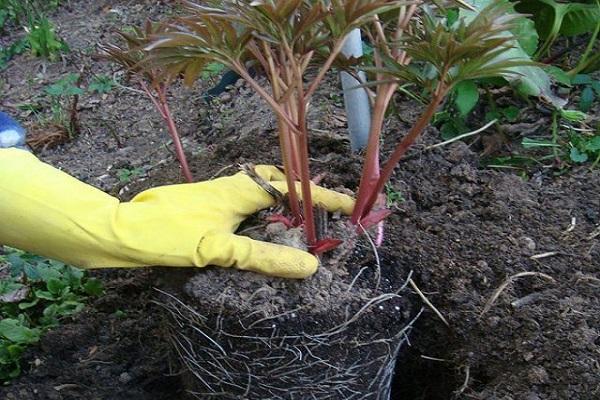

Care for peony thin-leaved in the open field
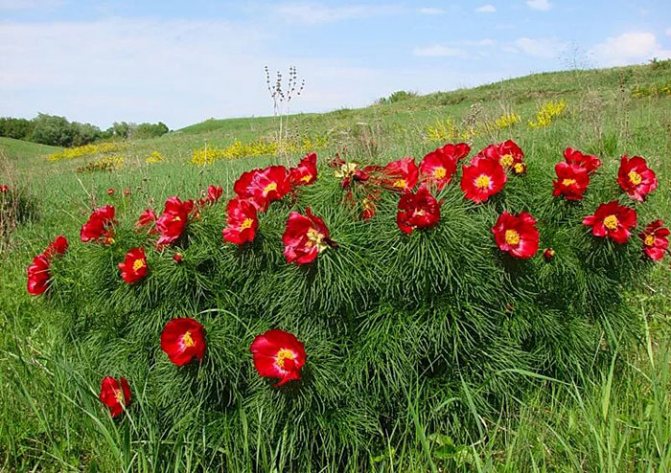

Although the narrow-leaved peony cannot be called a whimsical plant, it still requires minimal care and attention. Correct cultivation technique ensures that the plant retains its decorative effect and will delight with bright, spectacular flowers from year to year.
- Watering is carried out as the top layer of the soil dries up, but you should not allow the formation of a crust. On average, it is necessary to moisten the soil in drought at a frequency of 3-4 times a week. The amount of water for irrigation should not be large - observe moderation so that the root system does not suffer from stagnant moisture;
- Loosening of the soil is necessary for good aeration of the root system, and this manipulation is carried out carefully. Near a bush, it is recommended to deepen the tool no more than 5-7 cm, and at a distance of 20-25 cm from the bush, the depth can be increased to 10-15 cm. Be sure to loosen the soil after rains or watering;
- Mulching is an optional maintenance measure, but it can be used to successfully control weeds and prevent the rapid evaporation of moisture from the soil. It is best to use peat or humus as mulch, sprinkling them in a thin layer on the ground around the bush;
- Fertilization contributes to the correct development of the perennial, as well as better and more abundant flowering. However, if the soil was fed directly during planting, then during the first years the seedlings will not need additional nutrition. Beginning in the third year, fertilize the fine-leaved peony as follows:
- in the spring - 50 g of urea and ammonium nitrate (under a bush), saltpeter or carbide (50-60 g).
- in summer and autumn - mineral formulations with a high content of phosphorus and potassium according to the instructions on the package;
- Transplanting a thin-leaved peony is not often required - about once every 5 years. This is due to the fact that the plant grows very slowly. It is best to do garden work in the fall, when the perennial root system is forming. In order for the bush to endure the change of "place of residence" painlessly, remove it together with the earthen lump and move it to a new bed.
The narrow-leaved peony is a fairly resistant plant to pests and diseases, but it can suffer from fungal diseases due to disturbed watering. There is also a risk of damaging bushes by caterpillars or aphids at the beginning of the growing season. Ash, dolomite flour, mineral dressings with a high content of copper and calcium are excellent prophylactic agents for possible ailments.
Care
In order for the plant to develop fully, it is necessary to provide it with high-quality care. It should be comprehensive.
Watering
This is a fairly hygrophilous culture that requires systematic soil moistening.In summer, each seedling is recommended to be watered at least 3 times a week. It is important to remember about a sense of proportion. Stagnant liquid will harm the plant. When watering, you should focus on the appearance of the soil. When it dries, you can water the peony.
Top dressing
When using fertilizers when planting in the first 2 years, the crop can not be fed. It is worth applying fertilizers from the third year. In the spring, it is recommended to add 50 grams of ammonium nitrate and urea under each bush.
In the summer, it is worth using complex mineral preparations. In the fall, the peony needs to use potassium and phosphorus-based dressings. At the same time, an excess of nitrogen is harmful to the plant - it leads to a decrease in the number of buds.
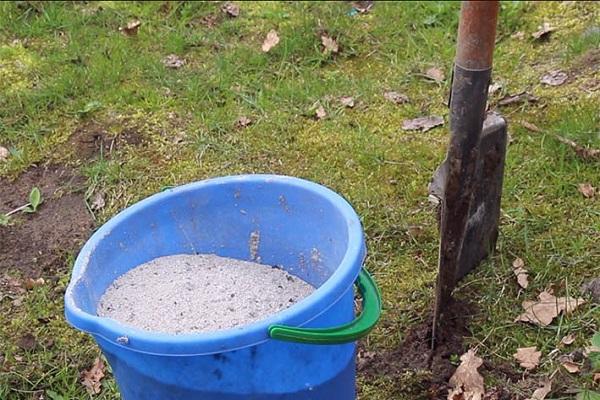

Loosening and weeding
The soil around the plant should be systematically loosened. Peonies thrive in light and airy soil. The procedure should be carried out very carefully to avoid damage to the root system. It is recommended to loosen the ground near the roots by 5-7 centimeters in depth. In more remote areas, it is allowed to deepen by 10 centimeters.
Removal of weeds, which leads to the spread of diseases, is of no small importance. To reduce the number of waterings and to cope with weeds, gardeners are advised to mulch the soil. For this, humus or peat can be used.
Pruning
In the fall, the plant should be pruned. It is recommended to do this after the leaves have wilted. The bush should be cut to the root, after which a layer of peat should be made for the winter.
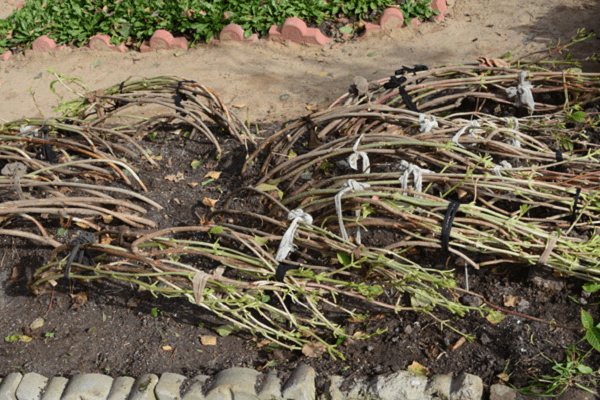

Shelter for the winter
Peony is resistant to frost. Therefore, it does not need to be covered before winter. But it is important to consider that with return frosts, the plant may die.
See also
Description and characteristics of peony varieties Henry Bokstos, cultivationRead
Diseases and pests
Flowers are eaten by ants, caterpillars, bronze beetles. To scare away insects, it is recommended to spray the bushes with hellebore infusion or an insecticidal preparation. Nematodes live on roots. For preventive purposes, the tops should be burned, and the soil should be dug up.
Peony can face such diseases:
- Gray rot. To avoid its development, the soil should be weeded and loosened. In early spring, the soil is treated with a fungicide.
- Brown spotting. Bordeaux liquid will help to cope with it.
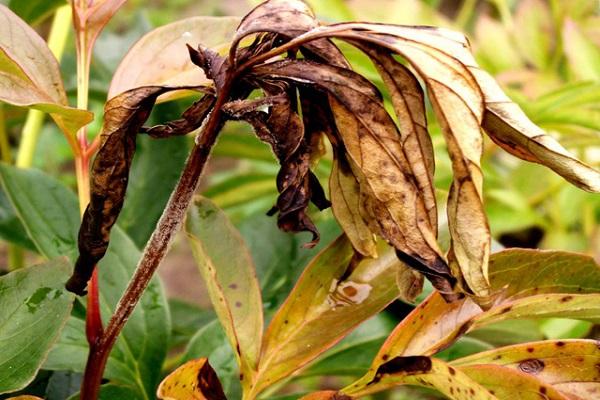

How to plant a thin-leaved peony correctly
The optimal time for planting narrow-leaved peony seedlings is the end of August or the first days of autumn. Take care in advance of preparing large seedling pits (about 70 cm deep and 60 cm wide). It is important to keep the distance between the holes at least 1 meter.
The landing technology itself is quite simple:
- At the bottom of the pit, a drainage layer (10-15 cm) is laid in the form of gravel, broken brick or fine crushed stone. This will prevent stagnation of moisture at the roots and their decay.
- A nutritious soil is compiled (1 bucket of humus, 2 tablespoons of wood ash, 100 g of superphosphate and 50 g of calcium sulfate) and laid on the drainage with a layer of about 15 cm.
- Then, in the middle of the hole, a mound of earth is poured, previously dug from the hole, on which the plant is placed.
- Peonies are covered with soil in such a way that the apical bud is only 6-7 cm below ground level.
- If you are planting delenki, be sure to treat the cuts with wood ash to prevent tissue decay.
The final stage of planting is the construction of a small hill around the seedlings and mulching the soil with humus or peat.
Reproduction
Thin-leaved peony can be propagated in various ways. Each of them has some peculiarities.
Dividing the bush
This is the most reliable way to rejuvenate adult cultures. To do this, you need to separate 2 roots 10 centimeters long in a finger thick. They should have 3-4 buds. The plant will take root quickly.
Seeds
It is worth planting seeds immediately after ripening.The sprouts will appear next spring or in 1-2 years. Reproduction of culture is a long process. It takes 5 years from planting seeds to the appearance of flowers.
Cuttings
Peonies can be transplanted with root cuttings with a bud. This is done in late August or early September. It is worth planting root shoots at a distance of 60-70 centimeters.
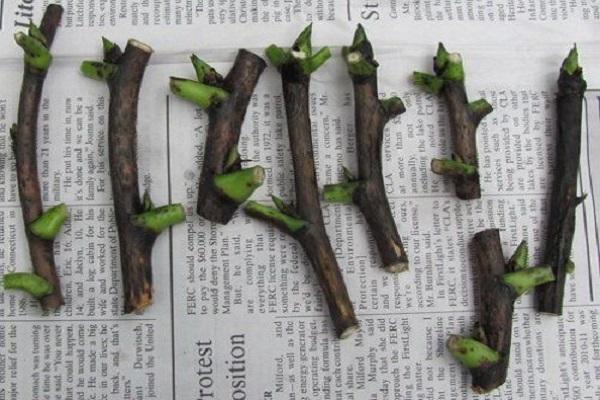

Harm and contraindications
The crow is a toxic plant. Even the slightest deviation from the doctor's recommendations and dosages can harm your body.
It should be remembered that folk remedies from peony are contraindicated in such categories of people:
- suffering from high acidity of the stomach, pancreatitis;
- patients with hypotension;
- people with liver and kidney problems;
- for pregnant and breastfeeding women, medications from Voronets are strictly prohibited;
- alcohol addicted;
Taking funds from the funnel can cause a number of side effects, including excessive sleepiness, exhaustion, bouts of vomiting and nausea, abdominal discomfort, a sharp drop in blood pressure, and allergic reactions.


Such an inconspicuous and rare flower, as you can see, is the source of many useful substances that are in great demand among doctors and healers. But only a properly organized treatment process can be beneficial, otherwise you will only harm yourself.
How to plant in winter
This peony can be planted in winter. In this case, a number of features should be taken into account.
Soil preparation
The plant requires nutritious fertile soil. It should have a neutral alkaline reaction. It is important to avoid acidic soil.
How to prepare seeds
Purchased seeds quickly lose moisture during long-term storage. The hard shell prevents the emergence of sprouts. To facilitate this process, the seeds should be soaked before planting.
How to plant
2 days after soaking, the seeds can be placed in the soil. This can be done in winter. To begin with, it is worth pouring sand into a wide container. It should be moistened, and then the seeds should be placed in the dish.
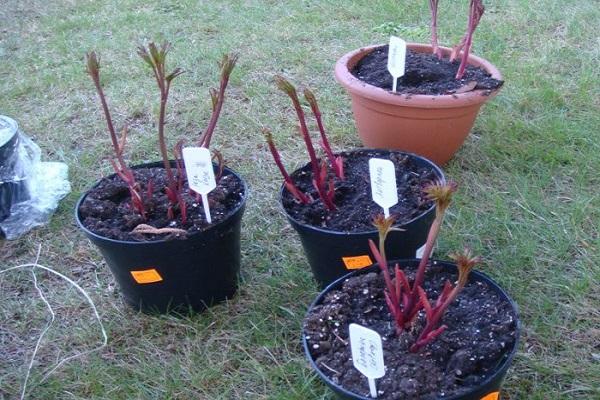

Temperature and light conditions
The container with seeds should be placed on a heating pad. During the day, the temperature should be 30 degrees, at night - 15. When the first leaves appear, the seedlings are transferred to a warm and bright place. The temperature should be 18-20 degrees.
Transfer to peat tablets
When the first roots appear, the seeds can be transplanted into fertile soil. Peat tablets are perfect for this purpose. They contain antibacterial agents and nutrients.
Dive
This procedure is recommended when 2-3 leaves appear on the plant. For this, each sprout is transferred to a separate container.
Hardening
It is allowed to transplant peonies into open ground after hardening. To do this, they should be taken outside for several days.
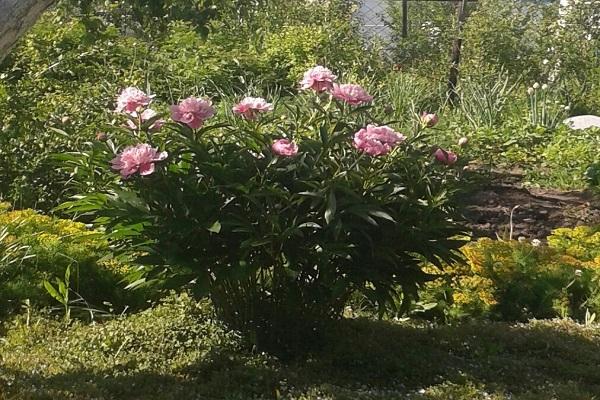

Landing in open ground
In late August or early September, seedlings should be planted in open ground. The development of the root system will continue in the fall. When grown from seed, flowers will appear only for 4-5 years.
Botanical description of the plant
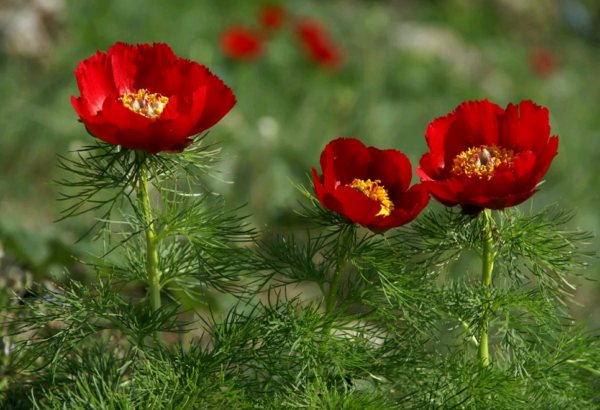

The crow looks decorative not only during flowering - even after the buds wither, the bush attracts attention with its original foliage. The height of adult specimens can vary from 40 to 60 centimeters, and flowering after planting occurs in 4-5 years. During the budding period, a large number of blood-red or yellow-purple buds with a diameter of 8-10 cm appear on the perennial. As a rule, they open almost simultaneously, so the narrow-leaved peony turns into a real ball.
Many gardeners grow thin-leaved peony precisely because of the delicate foliage, which is comparable in beauty to fern foliage. Thin, needle-shaped, cut twice or thrice, in large numbers it looks truly aristocratic. Its color is bright green and rich, so the peony does not lose its showiness throughout the warm season.
A characteristic feature of a thin-leaved peony is the "edge" of each flower with leaves. They are located around the bud, emphasizing the decorative effect of the plant. In addition, a pleasant, delicate aroma emanates from the flowers, which varietal varieties cannot boast.
The narrow-leaved peony is also known for its unpretentiousness, its ability to withstand severe frosts. That is why it is quite often grown in Siberia, where the harsh climate dictates its own conditions for landscaping garden plots. However, in other regions of Russia, the plant is used in landscape design to create natural flower beds, decorate stone slides and rock gardens.
Florist reviews
Numerous reviews confirm the excellent decorative properties of a thin-leaved peony:
- Anastasia: “I saw this peony from a neighbor in the country and asked her for the roots. This ornamental plant now adorns my site as well. "
- Valentina: “I have been growing narrow-leaved peonies in my country house for a long time. I like this plant very much, but it is quite whimsical. "
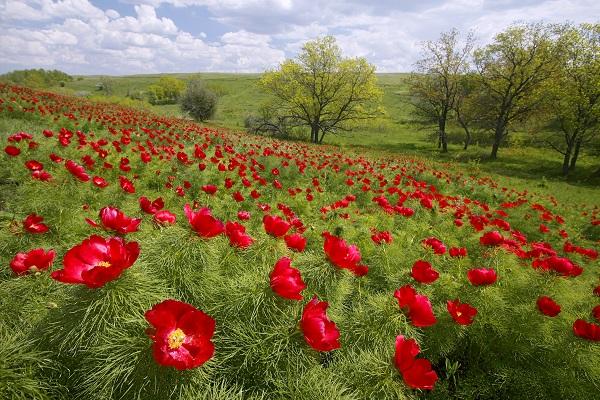

Growing conditions
This plant is quite unpretentious and can easily tolerate small frosts or droughts. Even a beginner grower is quite capable of growing a narrow-leaved peony. However, some conditions should be observed in order for the plant to be a decoration of the garden for as long as possible.
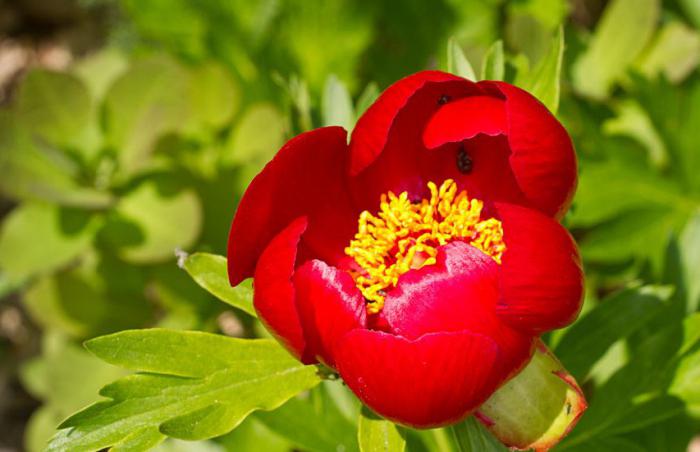

A peony needs well-lit places; with a lack of light, flowers may simply not appear on it. The soil should be moderately moist. Excessive waterlogging leads to decay of the root system. Good watering is required only during the bud ovary period. It is not recommended to plant the narrow-leaved peony on sandy soils. Decreased flowering can cause overuse of fertilizers.
Dangerous climb or fun walk
You can get to the peony fields on your own, but it is quite difficult. No one wants to waste time and energy, and find a lonely bush or two in the mountains. Locals know very well the places where the wild peony grows in a solid carpet. They will always tell you both the main landmarks of these areas (the name of a nearby settlement or a large mountain range) and smaller ones (a cave, an unusual tree, a river). But for an independent search for Crimean peonies, this may not be enough. Tourists need to either know the area well, or be ready to persistently and for a long time look for the right points on the map.
The best scenario for a "flower trip" is to make an appointment in advance with an experienced guide from Crimea, who knows not only the most "fruitful" locations, but is also well versed in the flowering calendar. Not all peonies in Crimea are revealed at the same time, so the route of a trip to them in early April, for example, will differ from a similar trip in May.
Reason to pack your suitcase
Of course, all wild peonies in Crimea are unusually good and therefore they annually attract nature lovers to their places of growth. Peonies blooming in the mountains are a spectacular sight in itself. Flower petals flutter in the wind, creating the illusion of a burning flame. Imagine what not one such flower looks like, but a whole field of "fire".
But in the search for these "scouts of spring" there is one more plus - wild flowers can be seen only in those parts of the Crimea, where there are not a lot of tourists, where nature has been preserved in its original form. Peonies are like beacons by which you can get to the most beautiful corners of the peninsula. Mountain peaks, lakes and the Black Sea serve as a backdrop for bright flower fields.
Protection of narrow-leaved bushes from pests
Another danger for Voronets is pests in the face of various insects. During the periods of their spread, it is recommended to pay special attention to the flower.
Most often they harm the plant:
- Ants. These insects appear during the budding period. You can get rid of them with the help of such means as "Fufanon" and "Iskra".
- Aphid. You can spot aphids on the back of the leaves. It is not difficult to eliminate it - it is enough to direct a stream of water with a strong pressure to their location. If it was not possible to get rid of all the insects, the plant should be treated with Karbofos or Aktellik.
- Caterpillars. You can get rid of it mechanically by collecting insects and their larvae with your hands. This method is applicable only in the case of light infestation by pests.
Important! When using poison from pests, you must follow the instructions on the package.
5 / 5 ( 1 vote)
The use of narrow-leaved peony in landscape design
Most often, the narrow-leaved peony is used to decorate alpine slides. The flower beds look interesting in combination with flax, broom shrubs or cereals. Experienced gardeners plant several varieties of peony at the same time to ensure flowering throughout the season. A narrow-leaved peony among stone and minimalistic compositions will look harmonious.
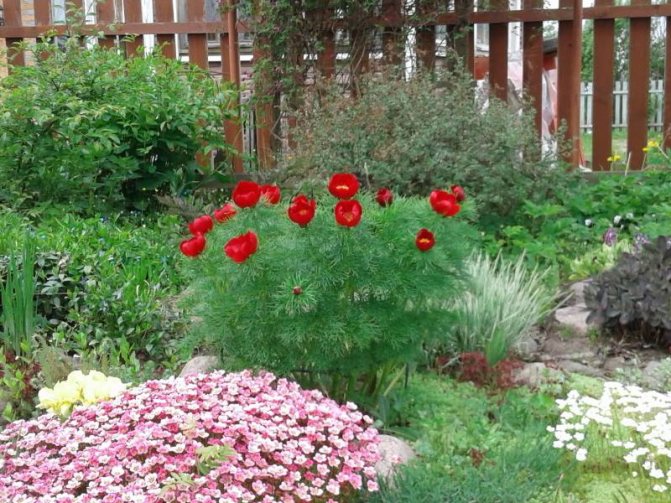

Narrow-leaved peony is used in garden design
History of origin
Little is known about the history of the origin of the peony. However, there are some mentioning, saying that during its existence, it either gained or lost popularity.
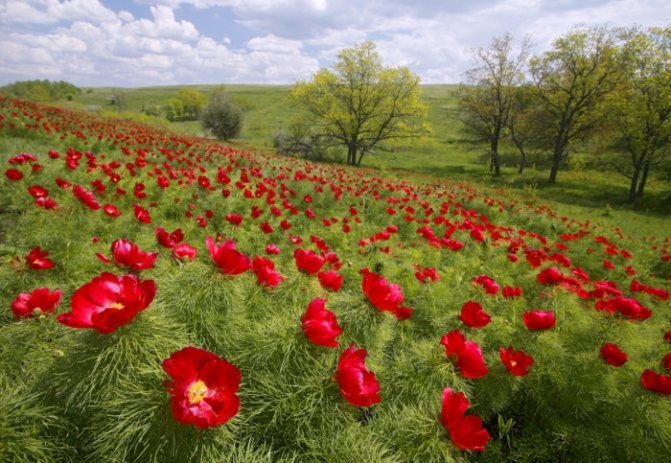

So:
- in the early 16th century, the flower was cultivated in London for sale;
- at the end of the 18th century it was popular with German gardeners;
- cultivation was also widespread in the 70-80s of the 20th century.
In Crimea, for a long time it was perceived as a weed, but at the moment it is gaining popularity again both in Russia and in Europe. It is rarely found in the wild, therefore it is a copy of the red book. Southeastern Europe and the Caucasus are considered the birthplace of wild Voronts.
Foreign peony
Another, no less wonderful representative of a glorious family - a resident of Asia Minor, Southern Europe and the Balkans - foreign peony, its other name is vagrant (p. peregrina). The eastern part of its range enters Moldova, where it is extremely rare and is taken under state protection. Outwardly, only a bright red flower has in common with a thin-leaved peony, but in general the plant is very different: it is taller (up to 60-80 cm), the bush, although not small, is compact. It is distinguished from other species by its very beautiful glossy dark green foliage. And there is one characteristic feature: its leaf blade ends with 3 teeth, which makes the plant unique in the garden.
There is a legend about one of the merchants in Russia, who almost lost his life, getting this wonderful flower for his beloved daughter. Then the legend was translated by the people into the tale of the Scarlet Flower. Remember how the merchant went across the seas. If we shift this to geography, then he traveled beyond the Black Sea, to the distant Ottoman-Byzantine lands, where the foreign peony still grows.
In the garden culture of Siberia, he has established himself on the good side. It reproduces easily vegetatively, like the raven peony.
Prevention of treatment of diseases
Most of all, peonies are susceptible to fungal diseases, which can occur due to excessive watering. If it was not possible to prevent the occurrence of the fungus and the plant got sick, then it is recommended to use fungicides and process the flower in one of three ways:
- classical;
- biological;
- complex.
The choice of technique depends on the neglect of the disease.
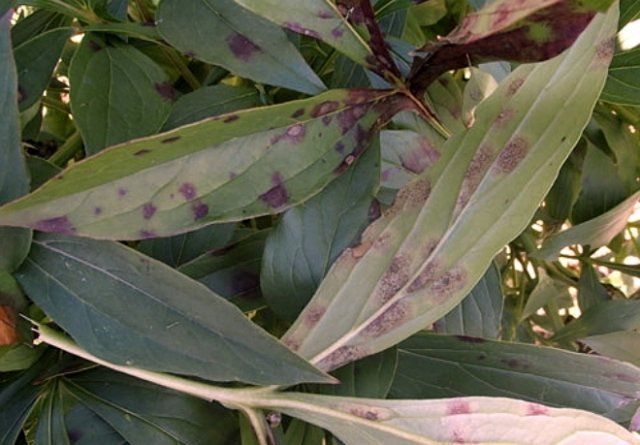

Important! To protect the plant from various diseases, it is necessary to fertilize it regularly and correctly.
The right route is the key to success
It is impossible to visit all of the listed places at once at the peak of flowering. If you have come to Crimea and want to see a lot of peonies, then you should ask local residents to suggest the route of the trip. It is better to build it in such a way as to visit three or four locations at once. Then great impressions and photos can be guaranteed with maximum probability.
The above description does not include absolutely all "pion deposits", but the largest ones are listed.The main thing to remember is that not all of Crimea is a suitable territory for these rare primroses. For example, the cities of Sevastopol or Kerch cannot offer their tourists to admire the spectacle of the "Peony Sea", where the arrival of spring is marked by the appearance of poppies and tulips.
Maryin Root
Take even the well-known Siberian peony Maryin root, or evading peony (p. Anomala). In addition to the usual two colors, lilac-pink and deep pink, he has variations with scarlet, crimson, red, apple-pink and white colors. Also found are forms with bright green, lettuce, olive green, brownish and thinly dissected foliage. Imagine if all these bushes, which are completely different from each other, bloom in the garden at the same time, and all this is Maryin's root!
I've been collecting for many years wild peonies... I have already collected more than 40 of their variations and I will say that when they bloom, the spectacle is mesmerizing. Through an exchange with other collectors from all over the world, a unique collection of wild peonies from Europe, the Caucasus, the Far East - places famous for the largest number of natural species and a variety of their forms has been collected over several years. Among such an abundance in garden culture, the most decorative species have established themselves.
[ad # ad-1]
A tip from a seasoned tourist
Of course, a trip to the peonies is not a serious multi-day hike in the mountains, but even for such a route it is important to be well prepared. You must be wearing:
Comfortable clothes
Free, multi-layered, able to protect from heat and wind, because the weather in the spring in the Crimea is still quite capable of presenting surprises.
Footwear
Lightweight, athletic, with flexible sole.
Headdress
Suitable for sun and / or wind protection. Sunglasses may come in handy. It is worth taking cosmetics with UV protection. A tourist rug (for relaxing on the grass) will also be useful.
And the most indispensable thing for such a trip is a camera, because you will want to take dozens of pictures. Surprisingly, wild peonies somehow turn photos of flowers into a heartfelt landscape by themselves, this has already been verified many times.

